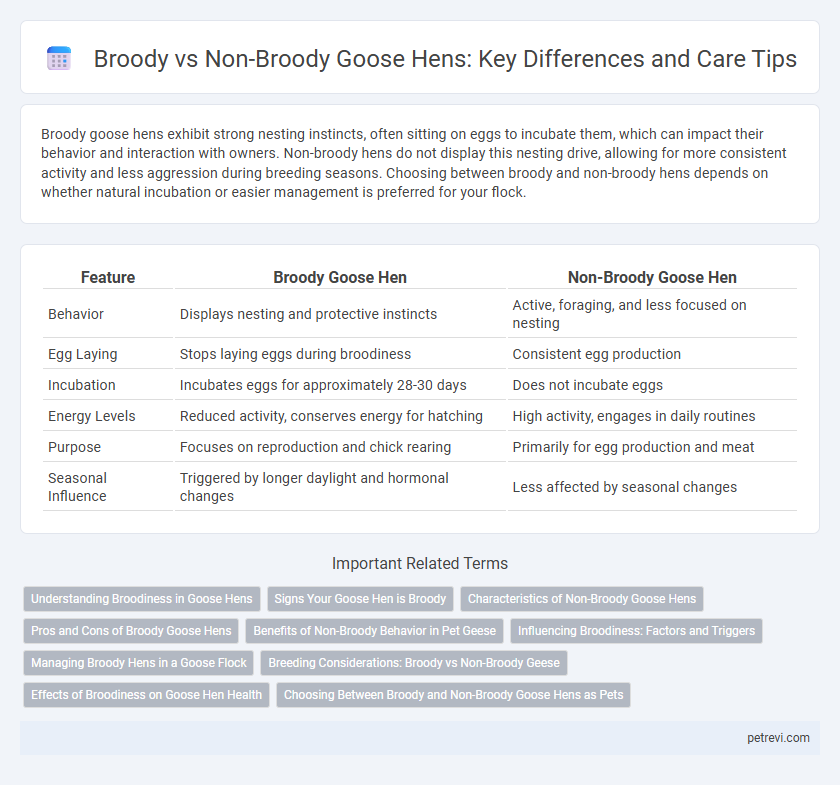Broody goose hens exhibit strong nesting instincts, often sitting on eggs to incubate them, which can impact their behavior and interaction with owners. Non-broody hens do not display this nesting drive, allowing for more consistent activity and less aggression during breeding seasons. Choosing between broody and non-broody hens depends on whether natural incubation or easier management is preferred for your flock.
Table of Comparison
| Feature | Broody Goose Hen | Non-Broody Goose Hen |
|---|---|---|
| Behavior | Displays nesting and protective instincts | Active, foraging, and less focused on nesting |
| Egg Laying | Stops laying eggs during broodiness | Consistent egg production |
| Incubation | Incubates eggs for approximately 28-30 days | Does not incubate eggs |
| Energy Levels | Reduced activity, conserves energy for hatching | High activity, engages in daily routines |
| Purpose | Focuses on reproduction and chick rearing | Primarily for egg production and meat |
| Seasonal Influence | Triggered by longer daylight and hormonal changes | Less affected by seasonal changes |
Understanding Broodiness in Goose Hens
Broody goose hens exhibit a natural instinct to incubate eggs, often sitting persistently on the nest for 28 to 35 days to ensure hatching success. Non-broody hens lack this strong nesting drive, allowing for more frequent egg-laying but requiring artificial incubation for reproduction. Understanding broodiness in goose hens helps farmers manage breeding cycles and optimize flock productivity.
Signs Your Goose Hen is Broody
Signs your goose hen is broody include persistent nest sitting, refusal to leave the nest even when disturbed, and aggressive behavior towards intruders. A broody goose hen often plucks feathers from her breast to line the nest, creating a warm environment for eggs. Reduced feeding and vocalizing softly are common indicators reflecting her focus on incubating eggs.
Characteristics of Non-Broody Goose Hens
Non-broody goose hens exhibit consistent egg-laying behavior without the instinct to incubate, allowing for higher egg production rates throughout the season. These geese remain more active and forage regularly, displaying less territorial aggression compared to broody hens. Their reproductive cycle is characterized by shorter clutches and frequent egg-laying intervals, ideal for commercial egg production and flock expansion.
Pros and Cons of Broody Goose Hens
Broody goose hens exhibit strong maternal instincts, providing natural warmth and protection essential for successful egg incubation and gosling survival. Their broody behavior ensures higher hatch rates and reduces the need for artificial incubation, but prolonged brooding can lead to poor egg production and weight loss. Non-broody geese maintain consistent egg laying and allow for greater farm productivity, yet require alternative incubation methods to hatch eggs effectively.
Benefits of Non-Broody Behavior in Pet Geese
Non-broody goose hens exhibit increased egg production and consistent laying patterns, making them ideal for pet owners seeking a steady supply of eggs. Their non-broody behavior reduces aggressive nesting tendencies, leading to more sociable and manageable geese in household environments. These traits contribute to healthier, less stressed geese while ensuring efficient egg harvesting without interruptions caused by incubation periods.
Influencing Broodiness: Factors and Triggers
Broodiness in goose hens is influenced by hormonal changes, environmental conditions, and breed-specific traits, with increased prolactin levels playing a critical role in initiating nesting behavior. Factors such as daylight length, temperature, and nesting availability significantly trigger or suppress broodiness, where shorter daylight and a secure, secluded nesting site typically promote incubation instincts. Non-broody geese often result from selective breeding or environmental stressors that alter hormonal balance, reducing the likelihood of nesting and allowing for continuous egg production.
Managing Broody Hens in a Goose Flock
Managing broody hens in a goose flock requires close observation, as broody geese exhibit persistent nest-sitting behavior and may stop laying eggs. Providing a separate, comfortable nesting area with minimal disturbance encourages natural incubation, while gently discouraging brooding tendencies in non-productive hens can help maintain egg production. Regularly rotating broody hens off nests and offering distraction through foraging opportunities reduces stress and promotes flock harmony.
Breeding Considerations: Broody vs Non-Broody Geese
Broody geese demonstrate strong nest-keeping instincts, making them ideal for natural incubation and hatching of goslings, while non-broody geese lack this maternal behavior and require artificial incubation for successful breeding. Choosing broody geese enhances hatch rates and reduces the need for human intervention, important factors for sustainable flock management. Breeders must weigh the reliability of broody hens against the advantages of non-broody geese's continuous egg production when planning breeding cycles.
Effects of Broodiness on Goose Hen Health
Broody goose hens often experience reduced feed intake leading to weight loss and weakened immune function due to prolonged sitting on nests. Non-broody hens maintain regular eating and activity patterns, supporting better overall health and higher egg production efficiency. Chronic broodiness can increase stress and susceptibility to diseases, impacting the hen's longevity and reproductive performance.
Choosing Between Broody and Non-Broody Goose Hens as Pets
Selecting between broody and non-broody goose hens depends on your goals for pet care and breeding. Broody geese exhibit natural nesting behavior, ideal for hatching eggs and raising goslings, while non-broody hens are better suited for consistent egg production and minimal intervention. Consider your preference for engagement in gosling rearing and the level of maintenance when deciding which type best fits your household or farm environment.
Broody vs Non-broody for Goose Hen Infographic

 petrevi.com
petrevi.com